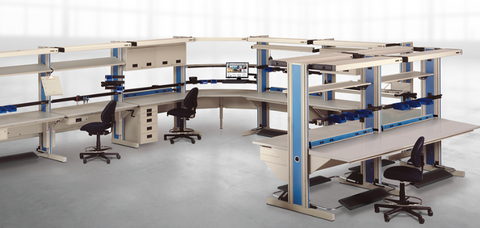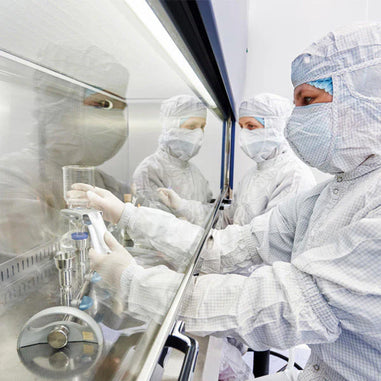- No products in the cart.
Laboratories are the hubs of scientific discovery, innovation, and experimentation. From pharmaceutical research to cutting-edge technology development, the efficiency of a lab directly impacts the quality and speed of results. Among the foundational elements that contribute to lab efficiency are well-designed lab benches and workstations. In this comprehensive guide, we'll explore the critical considerations, best practices, and innovative approaches to designing lab benches and workstations that optimize workflows and enhance scientific excellence.
The Role of Lab Benches and Workstations
Lab benches and workstations are the command centers of scientific endeavors. They serve as multifunctional platforms where experiments are conducted, equipment is operated, and samples are prepared and analyzed. The design of these spaces greatly influences researchers' productivity, safety, and overall work experience.
Key Considerations
-
Ergonomics: Ergonomics is a cornerstone of effective lab design. Workstations should be adjustable to accommodate researchers of varying heights, reducing strain and enhancing comfort during extended periods of work.
-
Flexibility: Labs often handle diverse projects with varying equipment needs. Design benches and workstations that are adaptable and can be reconfigured to accommodate different experiments and workflows.
-
Accessibility: Easy access to tools, instruments, and materials is crucial. A well-organized workspace minimizes time spent searching for items, optimizing efficiency.
-
Safety: Implement safety features like chemical-resistant surfaces, fume hoods, and emergency eyewash stations. Ensuring researchers can work safely contributes to both productivity and peace of mind.

Optimizing Workflow Efficiency
Efficiency in a lab is synonymous with optimized workflows. Lab benches and workstations play a pivotal role in achieving this efficiency.
Layout Considerations
-
Zoning: Divide the workspace into zones based on the tasks performed. For instance, separate areas for sample preparation, instrumentation, and data analysis can prevent cross-contamination and improve organization.
-
Proximity: Position frequently used equipment and materials within easy reach of researchers. Minimizing the distance between workstations and tools streamlines processes.
-
Traffic Flow: Design workstations to facilitate smooth movement within the lab. Unobstructed pathways prevent bottlenecks and promote efficient collaboration.
Integration of Technology
Modern labs heavily rely on advanced technology. Integrate power outlets, data ports, and connectivity solutions into lab benches and workstations. This enables seamless use of instruments and devices without cluttering the workspace with cables.
Innovations in Lab Bench Design
In recent years, lab bench design has evolved to meet the changing needs of scientific research.
Modularity and Flexibility
Modular lab benches have gained popularity due to their adaptability. Components like shelving, drawers, and dividers can be easily reconfigured to suit specific experiments. This versatility extends the life of lab furniture and accommodates evolving research needs.
Height-Adjustable Benches
Height-adjustable lab benches cater to the ergonomic needs of researchers. They allow users to alternate between sitting and standing positions, reducing strain and enhancing comfort during long hours of work.
Integrated Data Management
Smart lab benches equipped with integrated data management systems streamline data collection and analysis. Researchers can directly input observations, reducing the risk of transcription errors and expediting data processing.
Customization and Future-Proofing
Each lab has unique requirements, making customization a key consideration.
Industry-Specific Needs
Pharmaceutical labs, electronics R&D centers, and biological research facilities have distinct requirements. Customizing lab benches to meet these specific needs maximizes efficiency and supports specialized research processes.
Scalability
Consider the growth trajectory of the lab. Invest in lab benches and workstations that can be easily expanded or scaled down as the research scope changes.
Conclusion
Designing efficient labs is a multidimensional endeavor that hinges on thoughtful planning and innovation. Lab benches and workstations are integral components of this process, acting as the canvas upon which scientific breakthroughs are realized. By embracing ergonomic principles, optimizing workflows, integrating technology, and considering future needs, laboratories can create environments where researchers thrive, experiments flourish, and innovation knows no bounds. In the realm of scientific progress, the design of lab benches and workstations truly lays the foundation for excellence.
For over 40 years, Lab Pro Inc. is your steadfast source for premium lab workbenches and furniture, cleanroom lab supplies, hand tools, lab equipment, chemicals, and PPE apparel. Trusted by aerospace industries, medical device companies, and laboratories globally, we epitomize exceptional quality in every product. Experience the convenience of next day service in California. Contact us online or at 888-452-2776 to explore solutions tailor-made for the laboratory industry. Elevate your experiments with Lab Pro Inc. – your partner in precision and excellence.












































